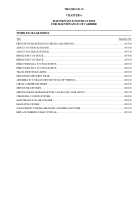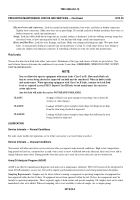TM-9-2350-261-10 - Page 452 of 761
TM 9-2350-261-10
PREVENTIVE MAINTENANCE CHECKS AND SERVICES — Continued
0075 00
Electrical wires and connectors:
Look for cracked or broken insulation, bare wires, and loose or broken connectors.
Tighten loose connectors. Make sure wires are in good shape. If you find cracked or broken insulation, bare wires, or
broken connectors, notify unit maintenance.
Straps:
Look for rubber hold-down straps that are cracked, broken, or hardened. Look for webbing stowage straps that
are frayed, worn, or have missing metal ends. If you find any bad straps, notify unit maintenance.
Hoses and fluid lines:
Look for wear, damage, and leaks. Make sure clamps and fittings are tight. Wet spots show
leaks. A stain around a fitting or connector can also mean there is a leak. If a leak comes from a loose fitting or
connector, tighten each fitting or connector. If something is broken or worn out, notify unit maintenance.
Fluid Leaks
You need to know how fluid leaks affect your carrier. Definitions of the types and classes of leaks are given below. You
need to know them to determine the condition of your carrier. Learn them. REMEMBER: WHEN IN DOUBT, NOTIFY
UNIT MAINTENANCE!
NOTE
You are allowed to operate equipment with minor leaks (Class I or II). How much fluid each
item or system being checked or inspected can hold must be considered. When in doubt, notify
unit maintenance. When operating equipment with Class I or II leaks, continue to check fluid
levels as required in your PMCS. Report Class III leaks to unit maintenance for corrective
action right away.
Any fuel leak will make the carrier NOT READY/AVAILABLE.
CLASS I
Seepage of fluid is not great enough to form drops, but is shown by
wetness or color changes.
CLASS II
Leakage of fluid is great enough to form drops, but drops do not drip
from the item being checked or inspected.
CLASS III
Leakage of fluid is great enough to form drops that fall from the item
being checked or inspected.
LUBRICATION
Service Intervals — Normal Conditions
For safer, more trouble-free operation, see to it that your carrier is serviced when it needs it.
Service Intervals — Unusual Conditions
Your carrier will often need extra service and care when you operate under unusual conditions. High or low temperatures,
long periods of hard use, continued use in sand, water, mud, or snow, will break down the lubricant, then you have to add or
change lubricant more often. During periods when the carrier isn’t used, the service intervals can be stretched out.
Army Oil Analysis Program (AOAP)
AOAP is an effective maintenance diagnostic tool and is not a maintenance substitute. TB 43-0211 must not be interpreted to
mean AOAP minimizes, in any way, the need to employ good maintenance practices and strong maintenance disciplines.
Sampling Requirements:
Samples may be taken without warming a component to operating temperature if equipment has
been operated within the last 30 days. If equipment has not been operated within the last 30 days, the components must be
brought to operating temperature. These requisites apply to both routine and special sampling. Oil samples must not be taken
immediately after oil is added. When oil sampling valve is not available to take oil sample, use a vampire pump.
0075 00-4
Back to Top




















